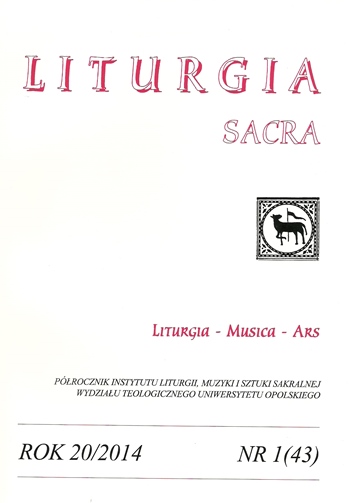Dramatyzacje liturgiczne Wielkiego Tygodnia w żagańskim klasztorze kanoników regularnych pod koniec XV wieku
The Liturgical Dramatization of the Holy Week in the Regular Canons Monastery of Żagań at the end of the 15th century
Author(s): Piotr Ziętek-KrysińskiSubject(s): Christian Theology and Religion, Theology and Religion
Published by: Uniwersytet Opolski
Keywords: Liturgical Dramatization; Holy Week; Regular Canons Monastery of Żagań
Summary/Abstract: The basis of the source considerations in this article is the manuscript book of musicalliturgical, that once belonged to the regular canons of the monastery of Żagań. This manuscript in the library catalogs is usually listed under the name Cantionale et Agenda. The main part of the manuscript is dated back to 1494 year and contains a description of the monastic liturgy on Holy Week. The article discusses all of Holy Week liturgical dramatization which are present in the book, i.e.: Processio in ramis palmarum, Denudatio et ablutio altaris, Mandatum, Depositio crucis and Elevatio crucis. These ceremonials are well known in the literature. Analysis of these celebrations showed that at the end of the fifteenth century in the monastery of Żagań a gradual disappearance of interference in the liturgy can be noticeable, and the rituals are evolving towards the more symbolic forms. That what happened for instance with the Palm Procession proposed by Cantionale et Agenda, which course was minimized to some actions and gestures was a prelude to the coming liturgical reform in the sixteenth century (The council of Trent). The unquestionable influence on it was the continually deepening of people’s awareness and understanding of the church rites by successive generations, which resulted transitioning to more theological forms, moreover, each age has its own and different spirituality and various internal needs. It should also be mentioned that this process did not only concerned to the abbey of Żagań, but also to the whole of the Diocese of Wrocław, where the official liturgy was indisputably the model for the Silesian regular canons as well. Nevertheless, the presented image of the Holy Week liturgical dramatizations still expresses the richness of ritual forms of the late Middle Ages.
Journal: Liturgia Sacra
- Issue Year: XX/2014
- Issue No: 43
- Page Range: 93-111
- Page Count: 19
- Language: Polish
- Content File-PDF

